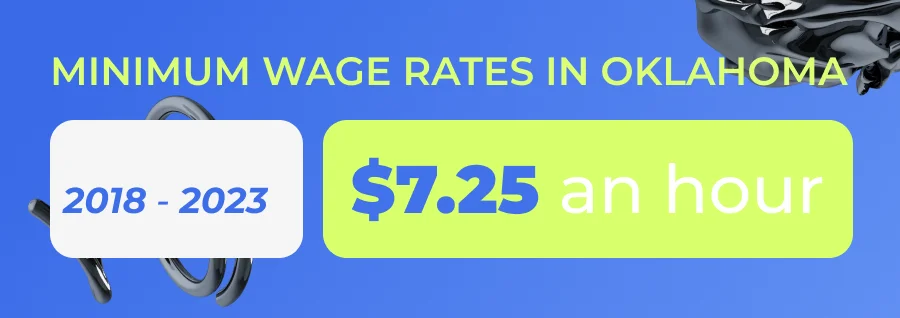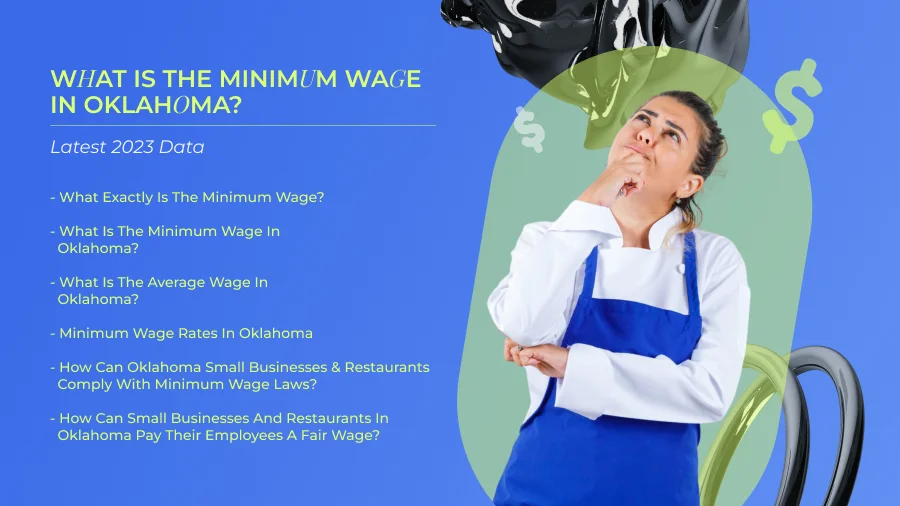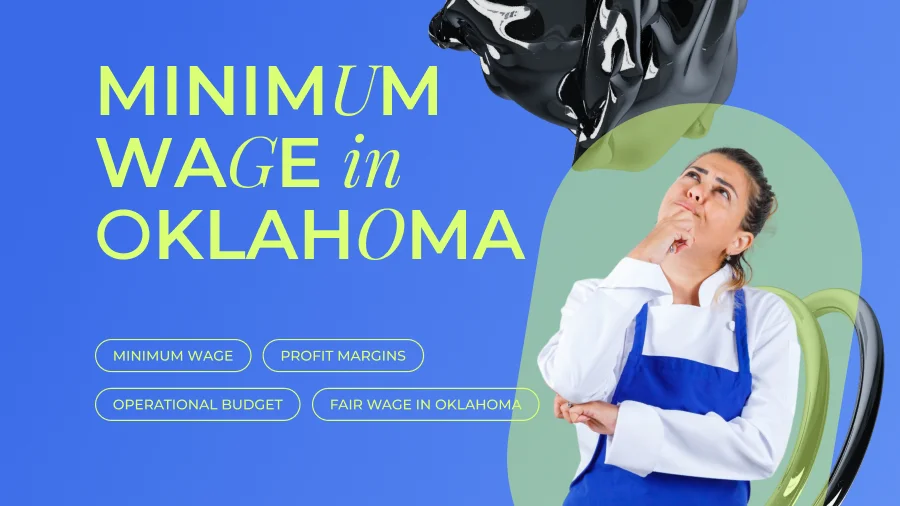What is the minimum wage in Oklahoma? Latest 2023 Data
This year, there is a lot of talk about raising the minimum wage in Oklahoma. As a business owner, you must stay on top of this topic. Not only is it vital to be compliant with the Fair Labor Standards Act (FLSA) but staying up-to-date on any Oklahoma minimum wage changes allows you to plan your business's future accordingly.
We've put up a guide just for you to help you understand what's going on with Oklahoma's minimum wage.
A minimum wage is the lowest wage per hour that a worker may be paid under federal law. It is a legally mandated price floor on hourly wages below which nonexempt workers may not be offered or agree to work.

What is the Minimum Wage in Oklahoma?
Oklahoma's minimum wage for employers in 2023 is $7.25 per hour, the same as the federal minimum wage set by the Fair Labor Standards Act. According to the US Labour Law Center, these are the previous and current Oklahoma minimum wage rates. However, several Oklahoma towns and counties have implemented their own minimum wage laws that set a higher minimum salary for employees in their jurisdiction. For example, Oklahoma City has a minimum pay of $11.50 per hour for employees working within the city limits, and Norman has a minimum wage of $12.00 per hour for employees working inside the city limits. Employees and employers should be informed of the minimum wage rules that apply to them, as they may differ depending on location.
It is worth mentioning that discussions and arguments over the Oklahoma minimum wage have occurred, including demands for potential hikes in recent years. Changes to the minimum wage in Oklahoma would require legislative action, and any revisions would be influenced by factors such as economic situations, political concerns, and public opinion on the importance of fair wages.
What is the Average Wage in Oklahoma?
Oklahoma's average wage varies by occupation and industry. As of 2023, the average hourly wage in Oklahoma is $19.89 per hour, with an annual salary of $41,371. This varies greatly depending on the occupation. For example, the average hourly income in Oklahoma for a retail salesperson is $11.81, while the average hourly wage for a registered nurse is $28.79.
In general, the highest-paid industries in Oklahoma are healthcare, banking, and energy. A healthcare administrator, for example, earns an average yearly pay of $89,000 in Oklahoma, but a financial analyst earns an average annual salary of $74,000. Retail and food service, on the other hand, are the lowest-paying industries in Oklahoma.
Minimum Wage Rates in Oklahoma

How Can Oklahoma Small Businesses and Restaurants Comply With Minimum Wage Laws?
We've looked at what minimum wage implies for employees, but what about employers? Inflation is having a significant impact on many businesses, and many restaurants report having trouble affording skilled workers. The minimum wage is higher than ever, and restaurants in Oklahoma must be able to pay at least minimum wage, if not more.
Restaurant profit margins and cost structures have historically been more reliant on minimum wage workers than other industries because the average profit margin in restaurants is only 3-5%. Other industries with substantially higher profit margins have historically been able to pay employees better. But, in order for restaurant work to be a viable job option, where employees choose to stay in the same place (rather than working numerous jobs), the business must discover ways to not just reach but exceed minimum wage.
How Can Small Businesses and Restaurants in Oklahoma Pay Their Employees a Fair Wage?
As previously said, a lot needs to happen for restaurant workers to be given a living wage. To begin, the industry-standard labor cost estimate of 30-35% is no longer accurate: labor cost will certainly account for a greater percentage of your operational budget than it did a few years ago.
Restaurants across the country have been forced to realize that labor costs are rising and will continue to grow as long as the cost of living continues to climb untamed. So, what can a restaurant do to recruit and retain the best staff with good pay and benefits?
1) Increase Prices
The vast majority of restaurants have had to raise prices in the last year to cover increasing ingredient costs, but you may have to raise prices again, by a larger amount, to provide a good wage for your workforce.
2) Trim Your Menu
Food waste is one of the most important controllable costs to reduce because it adds up quickly. Reduce the quantity of your menu and focus on the most popular and profitable items to reduce food waste and inventory expenses overall.
3) Ensure That Each Item is Used in Multiple Recipes
Extraneous ingredients that are only used in one recipe, for example, if you have a huitlacoche taco but never use the huitlacoche in anything else, it may be time to cut that item from your menu.
4) Implement a Service Charge
Try adding a % or amount-based charge to each bill but explain why it helps you retain your personnel well-paid and offer benefits. Check with your lawyer and accountant to see how this fee will affect your business's taxes.
5) Try Automated Gratuities
An automatic gratuity can help ensure that tips are distributed more evenly and regularly. If you do this, make sure to communicate this policy on your menu and on your website so that customers aren't taken by surprise. Consult your lawyer and accountant to learn how automatic gratuities can affect your business's taxes.
How Should Small Company Owners Prepare for Changes to the Minimum Wage?
Make sure you're ready as an employer if Oklahoma's minimum wage rises. Here are some pointers to help you prepare for a change in Oklahoma's minimum wage.
1) Examine Your Expenses
The simplest method to prepare for a state minimum wage increase is to thoroughly examine your business expenses. Is there anything you can cut back on?
2) Make the Proper Hires
The expense of replacing personnel, especially for a small business, can be significant. When you hire the right people, you reduce the entire cost of recruiting and training. Look for candidates who have a proven track record, come highly recommended, and fit well with your company's culture. Once they're onboarded, make sure you establish a relationship and provide paths for growth to ensure you retain excellent employees.
3) Increase Prices
Perhaps you need to bring in more cash flow to keep up with your employees' rising wages. Examine the price trends for the things you sell to see if you can effectively boost your prices. Remember, you don't want to disappoint your customers with an unnecessary price increase.
4) Update Your Technology
Having new technology can help you save time and money, especially if you choose technology that is priced for small businesses. You can save money by learning how to do payroll yourself.
Whether it's meeting the Oklahoma minimum wage or obtaining an EIN, Restaurantify is here to assist you not just in improving but also in growing your small business.
KEY TAKEAWAY!

